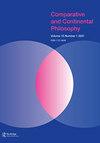The Legacy of Ueda Shizuteru: A Zen Life of Dialogue in a Twofold World
IF 0.3
0 PHILOSOPHY
引用次数: 0
Abstract
Ueda Shizuteru 上田閑照 (1926–2019) led a double life. And he taught us how we, too, can lead double lives. Or rather, he explained how we are already in fact doing so. It’s just that we don’t realize this. We are not awakened to, and thus do not fully actualize the fact that we always dwell, more or less, both within and beyond the linguistically constructed worlds of meaning that we co-create and that in turn co-create us. The more we become aware of this fact, the more capable we’ll become of creatively exiting and reentering these semantic spaces, and thus of living the kind of double life of dialogue that Ueda so well modeled in practice as well as mapped out in theory. Throughout his life, Ueda was devoted to engaging, primarily from the standpoint of Zen Buddhism, in interreligious as well as intercultural philosophical dialogue. In a retrospective essay written in 2004, Ueda wrote that his life and work took place within two kinds of “between spaces” (aida 間). He moved between “religious existence” (shūkyō-teki jitsuzon 宗教 的実存) and “philosophical thinking” (tetsugaku-teki shisaku 哲学的思索). And, for him, this entailed going between engaging with the spiritual traditions of East-Asia— the practice of Zen Buddhism in particular—and studying European traditions of philosophy and religion (Ueda 2005a, 18). No doubt Ueda was drawn to study Meister Eckhart—that unmatched medieval Meister of both life and letters—because he recognized a kindred attempt to live and think in between acute existential and intellectual demands. Sensing a similar combination of sincere spiritual practice and passionate scholarly thinking is probably also上田静人的遗产:两个世界对话的禅宗生活
上田静人上田閑照 (1926–2019)过着双重生活。他教会了我们如何过双重生活。或者更确切地说,他解释了我们实际上是如何做到这一点的。只是我们没有意识到这一点。我们没有意识到,因此也没有完全意识到这样一个事实,即我们总是或多或少地生活在我们共同创造的、进而共同创造我们的语言构建的意义世界之内和之外。我们越是意识到这一事实,我们就越有能力创造性地退出和重新进入这些语义空间,因此,上田在实践中和理论上都很好地塑造了对话的双重生活。上田一生致力于参与宗教间和文化间的哲学对话,主要是从禅宗的角度出发。在2004年写的一篇回顾性文章中,上田写道,他的生活和工作发生在两种“空间之间”(aida間). 他在“宗教存在”(shúkyō-teki jitsuzon宗教 的実存) 和“哲学思考”哲学的思索). 对他来说,这需要在接触东亚的精神传统——尤其是禅宗的实践——和研究欧洲的哲学和宗教传统之间进行(上田2005a,18)。毫无疑问,上田之所以被吸引来研究迈斯特·埃克哈特——一位无与伦比的中世纪生活和文学大师——是因为他认识到了在尖锐的生存和智力需求之间生活和思考的相似尝试。感受到真诚的精神实践和热情的学术思考的相似结合可能也是
本文章由计算机程序翻译,如有差异,请以英文原文为准。
求助全文
约1分钟内获得全文
求助全文

 求助内容:
求助内容: 应助结果提醒方式:
应助结果提醒方式:


